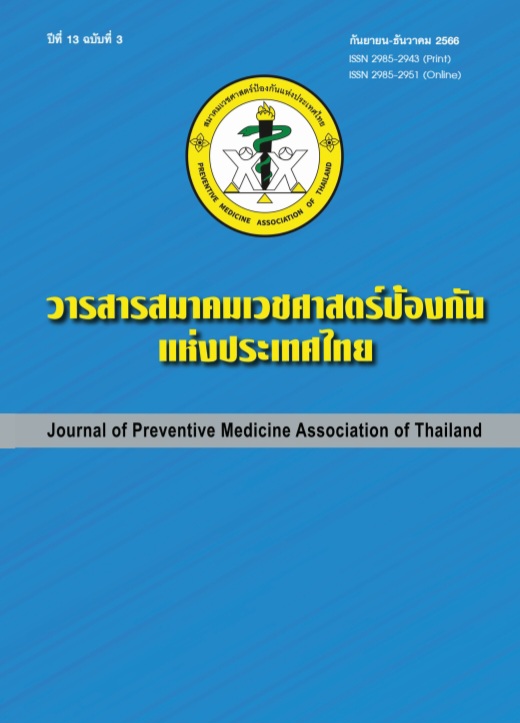Prevalence and Associated Risk Factors of Hypertension of Participant in Seafarer’s Medical Fitness Examination
Keywords:
prevalence, hypertension, seafarers, medical fitness examinationAbstract
Background: Hypertension is one of the major health problems. In Thailand, there is tendency to continually increase the number of patients with high blood pressure. In offshore operations, seafarers required to undergo medical examinations. Hypertension and chronic diseases are factors that must be considered for their fitness for work. Objective: To determine the prevalence and associated risk factors of hypertension of participant in seafarer’s medical fitness examination. Methods: The study design was a cross-sectional descriptive study. The study population were 1070 seafarers who came for medical fitness examination at private hospital, Bangkok from January 1 - December 31, 2022. Data were analyzed by descriptive statistics. The prevalence of hypertension was analyzed by proportion test and the associated factors were analyzed by multiple logistic regression. Results: Prevalence of hypertension in seafarers who came for medical fitness examination was 23.83 percent (95% CI: 21.31 – 26.50). The highest prevalence of hypertension by age group were 35.35 percent (95% CI: 26.54 – 45.29) in the age over 50 years and by body mass index level were 42.26 percent (95% CI: 35.40 – 49.84) in Obesity class 2. The associated factors of hypertension in seafarers were age, BMI, and blood sugar. Conclusion: Hypertension in seafarers’ medical fitness examination is an important health issue. Therefore, planning for health promotion program should be focus on lifestyle modification and diet control for well-being of seafarers.
References
Ádám B, Rasmussen HB, Pedersen RNF, Jepsen JR. Occupational accidents in the Danish merchant fleet and the nationality of seafarers. J Occup Med Toxicol 2014;9(1):35.
Lefkowitz RY, Slade MD. Seafarer mental health study final report, October 2019. London: ITF House; 2019.
Oldenburg M. Risk of cardiovascular diseases in seafarers. Int Marit Health 2014;65(2):53-7.
Hoeyer JL, Hansen HL. Obesity among Danish seafarers. Int Marit Health 2005;56(1-4):48-55.
Jepsen JR, Rasmussen HB. The metabolic syndrome among Danish seafarers: a follow-up study. Int Marit Health 2016;67(3):129-36.
วิชัย เอกพลากร, หทัยรัตน์ พรรคเจริญ, วราภรณ์ เสถียรนพเก้า. รายงานการสำรวจสุขภาพประชาชนไทยโดยการตรวจร่างกาย ครั้งที่ 6 พ.ศ.2562-2563. กรุงเทพ: คณะแพทยศาสตร์โรงพยาบาลรามาธิบดี มหาวิทยาลัยมหิดล; 2564.
Kannel WB. Fifty years of Framingham Study contributions to understanding hypertension. J Hum Hypertens 2000;14(2):83-90.
Singh S, Shankar R, Singh GP. Prevalence and associated risk factors of hypertension: a cross-sectional study in urban Varanasi. Int J Hypertens 2017;2017:5491838.
Nguyen T, Lau DCW. The obesity epidemic and its impact on hypertension. Can J Cardiol 2012;28(3):326-33.
International maritime organization. International convention on standards of training, certification and watch keeping for seafarers (STCW) [Internet]. 2010 [cited 2022 Jun 7]. Available from: https://www.imo.org/en/ourwork/humanelement/pages/stcw-conv-link.aspx
Ministry of public health, Thailand. Announcement of the ministry of public health on criteria, methods and conditions governing medical certificates of seafarers indicating the health preparedness for onboard operation [Internet]. [cited 2022 Jun 4]. Available from: https://www.imsasth.com/home/detail/34/?sID=34.
Thomas D. 7 diseases/disorders seafarers should be aware of [Internet]. 2019 [cited 2022 June 7]. Available from: https://www.marineinsight.com/marine-safety/7-dangerous-diseasesdisorders-seafarers-should-be-aware-of/.
International Labour Office. Guidelines on the medical examinations of seafarers. Geneva: ILO; 2013.
Tu M, Jepsen J. Hypertension among Danish seafarers. International maritime health 2016;67(4):196-204.
แจ่มจันทร์ จันทร์แจ้ง, พรชัย สิทธิศรัณย์กุล, เสฏฐศิริ แสงสุวรรณ. การเปรียบเทียบความชุกและปัจจัยที่เกี่ยวข้องกับโรคความดันโลหิตสูงระหว่างกำลังพลประจำเรือและกำลังพลหน่วยบกของกองทัพเรือ. วารสารแพทย์นาวี 2561;45(1):154-69.
Pougnet R, Pougnet L, Loddé B, Canals-Pol M, Jegaden D, Lucas D, et al. Cardiovascular risk factors in seamen and fishermen: review of literature. Int Marit Health 2013;(3):107-13.
Poorolajal J, Farbakhsh F, Mahjub H, Bidarafsh A, Babaee E. How much excess body weight, blood sugar, or age can double the risk of hypertension? Public Health 2016;133:14-8.
Faculty of Medicine Ramathibodi Hospital. Thai CV risk score [Internet]. 2015 [cited 2022 June 7]. Available from: https://www.rama.mahidol.ac.th/cardio_vascular_risk/thai_cv_risk_score/.
กองโรคไม่ติดต่อ กรมควบคุมโรค. รายงานสถานการณ์โรค NCDs, เบาหวาน ความดันโลหิตสูงและปัจจัยเสี่ยงที่เกี่ยวข้อง พ.ศ.2562. นนทบุรี: กองโรคไม่ติดต่อ กรมควบคุมโรค; 2563.
Downloads
Published
How to Cite
Issue
Section
License
Copyright (c) 2023 Journal of Preventive Medicine Association of Thailand

This work is licensed under a Creative Commons Attribution-NonCommercial-NoDerivatives 4.0 International License.
บทความที่ลงพิมพ์ในวารสารเวชศาสตร์ป้องกันแห่งประเทศไทย ถือเป็นผลงานวิชาการ งานวิจัย วิเคราะห์ วิจารณ์ เป็นความเห็นส่วนตัวของผู้นิพนธ์ กองบรรณาธิการไม่จำเป็นต้องเห็นด้วยเสมอไปและผู้นิพนธ์จะต้องรับผิดชอบต่อบทความของตนเอง






